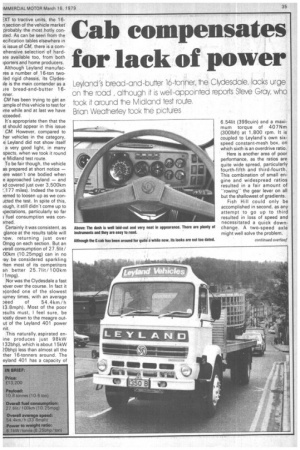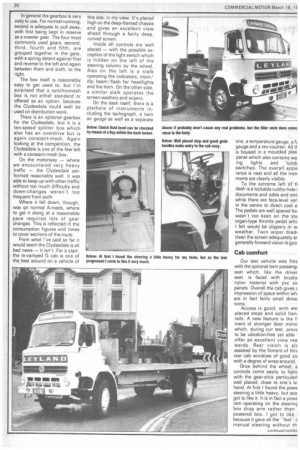Cab compensates for lack of power
Page 37

Page 38

Page 40

If you've noticed an error in this article please click here to report it so we can fix it.
Leyland's bread-and-butter 16-tanner, the Clydesdale, lacks urge on the road , ahnough it is well-appointed reports Steve Gray, who took it around the Midland test route.
Brian Weatherley took the pictures
EXT to tractive units, the 16n section of the vehicle market probably the most .hotly con3ted. As can be seen from the ecification tables elsewhere in is issue of CM, there is a corn.ehensive selection of hardare available too, from both iporters and home producers. Although Leyland manufacres a number of 16-ton two:led rigid chassis, its ClydesIle is the main contender as a ire bread-and-butter 1 6nner.
CM has been trying to get an ample of this vehicle to -test for ime while and at Last we have icceeded.
Its appropriate then that the st should appear in this issue CM. However, compared to her vehicles in the category, e Leyland did not show itself a very good light, in many spects, when we took it round e Midland test route.
To be fair though, the vehicle as prepared at short notice — 'ere wasn't one bodied when e approached Leyland — and ad covered just over 3,500km 1:177 miles). Indeed the truck aemed to loosen up as we conucted the test. In spite of this, lough, it still didn't come up to (pectations, particularly so far 5 fuel consumption was conarned.
Certainly it was consistent, as glance at the results table will how, returning just over Ompg on each section. But an verall consumption of 27.5Iit/ 00km (10.25mpg) can in no ray be considered sparkling (hen most of its competitors an better 25. 7lit/ 100km 11 mpg).
Nor was the Clydesdale a fast lover over the course. In fact it acorded one of the slowest )urney times, with an average peed of 54.4km/h 33.8mph). Most of the poor .asults must, I feel sure, be lostly down to the meagre outut of the Leyland 401 power nit.
This naturally, aspirated enme produces just 98kW 132bhp), which is about 15kW .20bhp) less than almost all the ther 16-tonners around. The eyland 401 has a capacity of 6.54Iit (399cuin) and a maximum torque of 407Nm (300Ibft) at 1,800 rpm. It is coupled to Leyland's own sixspeed constant-mesh box, on which sixth is an overdrive ratio.
Here is another area of poor performance, as the ratios are quite wide spread, particularly fourth-fifth and third-fourth. This combination of small engine and widespread ratios resulted in a fair amount of "rowing" the gear lever on all but the shallowest of gradients.
Fish Hill could only be accomplished in second, as any attempt to go up to third resulted in loss of speed and necessitated a quick downchange. A two-speed axle might well solve the problem. In general the gearbox is very easy to use. For normal running, second is adequate to pull away, with first being kept in reserve as a crawler gear. The four most commonly used gears, second, third, fourth and fifth, are grouped together in the gate, with a spring detent against first and reverse to the left and again between them and sixth, to the right.
The box itself is reasonably easy to get used to, but I'm surprised that a synchromesh box is not either standard or offered as an option, because the Clydesdale could well be used on distribution work.
There is an optional gearbox for the Clydesdale, but it is a ten-speed splitter box which also has an overdrive but is again constant-mesh. Again looking at the competition, the Clydesdale is one of the few left with a constant-mesh box.
On the motorway — where we encountered very heavy 'traffic — the Clydesdale performed reasonably well. It was able to keep up with other traffic without too much difficulty and down-changes weren't too frequent from sixth.
Where it fell down, though, was on normal A-roads, where to get it along at a reasonable pace required lots of gear changes. This is reflected in the consumption figures and times to cover sections of the route.
From what I've said so far it would seem the Clydesdale is all bad news — it isn't. For a start, the re-vamped G cab is one of the best around on a vehicle of this size, in my view. It's placed high on the deep-framed chassis and gives an excellent view ahead through a fairly deep, curved screen.
Inside all controls are well placed — with the possible exception of the light switch which is hidden on the left of the steering column by the wheel. Also on the left is a stalk operating the indicators, main/ dip beam /flash for headlights and the horn. On the other side, a similar stalk operates the screen-washers and wipers.
On the dash itself, there is a plethora of instruments including the tachograph, a twin air gauge as well as a separate
Below: Well placed step and good grabone, a temperature gauge, a ft handles make entry to the cab easy. gauge and a rev counter. All
is housed in a moulded plas panel which also contains wa ing lights and tumb switches. The overall appe rance is neat and all the instr ments are clearly visible.
To the extreme left of tl dash is a lockable cubby-hole1 documents and odds and enc while there are face-level ver in the centre to direct cool a The pedals are well spaced bu wasn't too keen on the ste organ-type throttle pedal whii I felt would be slippery in w weather. Twin wiper bladi clean the screen adequately ar generally forward vision is goo
Cab comfort Our test vehicle was fittE with the optional twin passengl seat which, like the driver seat, is faced with brushE nylon material with pvc sic panels. Overall the cab gives E impression of space within wh are in fact fairly small dime' sions.
Access is good, with we placed steps and solid ham rails. A new feature is the f, ment of stronger door mirro which, during our test, provE to be vibration-free yet able . offer an excellent view rea wards. Rear vision is alE assisted by the fitment of thrE rear cab windows of good si2 with a degree of wrap-around.
Once behind the wheel, a controls come easily to hanc with the gear-stick particularl well placed, close to one's le hand. At first I found the pow( steering a little heavy, but soo
got to like it. It is in fact a powE ram operating on the steerinc box drop arm rather than powered box. I got to like because it gave all the "feelc manual steering without th
effort.
For access to the power unit and other ancillaries, the cab can be tilted. However it is not the quick, simple operation that one has become used to on some of the Clydesdale's competitors. To tilt this one, two bolts have to be removed at the back and the gear-knob taken off.
When dropping the cab back, some care must be exercised to ensure the lever goes through the gaiter without difficulty. This is considerably better than it used to be though, where the steering column had to be moved to allow tilting.
Nevertheless, the cab does offer reasonable access in the tilted position, and tilting is truly a one-man business — even if it is a slow one. Once open, the cab is retained by a torsion-bar system with an over-centre stabiliser bar to prevent it dropping down unexpectedly.
The checking of other components is made easy by a separate flap within the glovebox to look at the clutch fluid and a hinged flap on the facia for inspection of the fuses. Instru ments can be replaced or in spected quickly by removing thE dash panel, held on by quick. release fasteners. At the back ty, the cab is the cooling systerr header tank, which is readily accessible.
Not so accessible, though, we found, certainly from a test point of view, was the fuel filler. The tank is round and the filler neck comes up very horizontally_ Though there's no problem in filling the tank with the hose, it's difficult to see just how much is in there with' a body on.
To sum the Clydesdale-up, I would say it is a solid workhorse, capable of doing the job it's designed for adequately. However, in terms of perfor mance, economy and cirivability, it lags behind the established, and not-so established, competition. Nevertheless it is reasonably priced, has been established on the market for quite a while now and so must represent a good investment for those seeking a simple formula. The price as tested was £13,200, but the basic chassis cab costs £12,190.
























































































































































